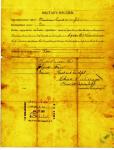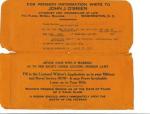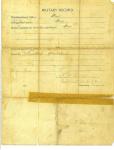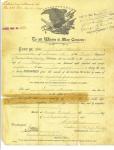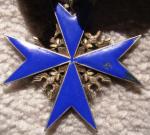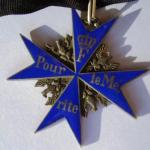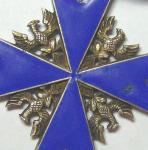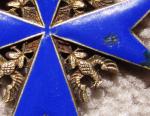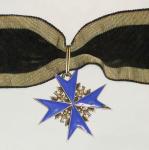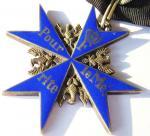
Mike
Past Contributor-
Posts
811 -
Joined
-
Last visited
-
Days Won
1
Content Type
Profiles
Forums
Blogs
Gallery
Events
Store
Everything posted by Mike
-
Since 4 of the Rough Rider Companies/Troops didn't have room on the Transports ...Frank Marion ( the Bugler for Troop "M" )..and the others were left behind in Florida and didn't make it to Cuba. But he didn't give up and after Mustering out of the Rough Riders , he enlisted in the 33'd Texas Infantry and fought in the Philippines. THIRTY-THIRD INFANTRY. The Thirty-third Infantry regiment of United States Volunteers, known as the "Texas Regiment" because of the popular belief that it was composed of ex-cowboys, was one of the most famous American combat units to serve in the Philippine Insurrection of 1898-1902. It was raised under the provisions of the Army Act of March 3, 1899, specifically for duty in the Philippines, and served in the archipelago from October 27, 1899, to March 2, 1901. The Thirty-third was commanded by Col. Luther Rector Hare,qv a tough regular army major who had commanded the First Texas Cavalry in 1898. Company officers were selected from a mixture of regulars, state militia, and veteran volunteers of the Spanish-American War. A third of the Thirty-third's officers came from Texas and another third from the Southwest and South, a geographic pattern that was followed by the enlisted men. The Thirty-third was organized in July and August at Fort Sam Houston and Camp Capron, near San Antonio, where the men were trained in marksmanship, skirmishing, and forced marching. In November and December 1899 the Thirty-third distinguished itself in the battles of Magnatarem, Tirad Pass, Vigan, and Taguidin Pass. From late December 1899 to February 1901, the regiment served as a counterinsurgency constabulary in the First District, Department of Northern Luzon, under the command of Gen. Samuel B. M. Young. The Thirty-third was dispersed into small garrisons throughout Abra and Ilocos Sur, and many officers assumed civil functions in these two provinces. These garrisons served as local strongholds from which American forces could control the countryside by hunting down guerrillas and cutting them off from the native populace. The regiment also organized a mobile mounted force, known as the "mosquito fleet," which served as an emergency reserve and raiding force. The regiment's garrison service was a major factor in restoring order to Abra and Ilocos Sur and preparing these provinces for American colonial government. Several of the men chose to remain in the Philippines to serve with the Philippine Constabulary, as native scouts, or as members of the colonial civil service. The rest of the regiment was withdrawn from northwestern Luzon in February and March and mustered out of United States service in San Francisco on April 17, 1901. http://www.tsha.utexas.edu/handbook/online/index.html
-
Howard Kelley just Emailed me after doing some nice research on this grouping. Thanks Howard Here?s what he came up with ---- >> > > The 1st United States Volunteer Cavalry, better known as the "Rough Riders" is one of the most well-documented and famous volunteer fighting forces in American history. The "Rough Riders" was formed from men from the western frontier of the United States, men who were used to life in the saddle and to the use of firearms - and from some eastern high-class young men who were athletic and also skilled in horsemanship and the use of guns...but for entirely different reasons. In addition there were men from almost everywhere else! The unit included miners, cowboys preachers, tradesmen, writers, professors, athletes, and clergymen. Remarkably, there were men from each of the forty-five states then in existence, the four territories and from fourteen countries! There were even sixty Native Americans on the roster. The unique combination reflected the interesting contrasts in one of the men who was one of the driving forces behind the unit ? Theodore Roosevelt, the man who was initially the regiment?s lieutenant colonel and later its colonel. >> When word went out that Roosevelt and Colonel Leonard Wood, were raising a regiment, volunteers from all over appeared. Twenty-three hundred men volunteered in the first twenty-four hours, of which only a small percentage could be accepted. Even the future creator of Tarzan, Edgar Rice Burroughs tried to enlist.>> The unit was mustered into service between May 1 and May 21, 1898 in various locations in Texas, New Mexico and what was then termed ?Indian Territory? (Arizona and Oklahoma ). At the time of muster in, the unit consisted of 47 officers and 994 enlisted men. The uniqueness of the regiment, the bombastic energy of Roosevelt(until recently the assistant secretary of the navy) and Roosevelt?s gift for public relations and self-promotion brought the unit much publicity even before its worth was proven in battle. >> From San Antonio, Texas, the unit was ordered, on May 27, to Port Tampa, Florida, for the invasion of Cuba. At Port Tampa, things were in great disarray, and the Vth Corps, of which the Rough Riders were now a part, was highly disorganized. In the confusion of embarking on the transports, several regiments were assigned to the same transport, the YUCATAN. Roosevelt got his men aboard, realizing that once aboard, would probably not be forced to disembark. The Rough Riders stayed aboard, to the chagrin of the other regiments. Sadly for some, because of a lack of room in the army transport, only eight of the regiment's twelve troops (troops A, B, D, E, F, G, K, and L) went to Cuba, with the other four (troops C, H, I, and M) remaining behind in Florida. Also, the regiment had to leave its horses behind in Florida, and essentially served in Cuba as an infantry regiment. >> In Cuba, the regiment fought at Las Guasimas, and then at the famous San Juanlace> and Kettle Hills. The regiment proved its worth and truly lived up to all of the publicity it had already received. For his efforts to lead in the assault at Kettle and San Juan hills, Roosevelt would eventually be awarded the Congressional Medal of Honor (an honor he truly earned, but which, for political reasons, he would not receive until over eighty years after his death). >> After the fighting ended and the summer wore on, disease among the troops began to rise. Eventually the War Department was embarrassed into bringing the battle-worn troops back home, to be replaced by other, fresh troops. The Rough Riders arrived back in the U.S. on August 15, three days after an armistice had been declared, and went into camp at Montauk Point, Long Island (Camp Wikoff), New York . >> The unit was mustered out of service on September 15, 1898 at Camp Wikoff. At the time of muster out, the unit consisted of 52 officers, and 1,185 enlisted men. During its term of service, the unit lost two officers and 21 enlisted men killed in action; and three more men died of wounds received in battle. Nineteen more men died of disease, and twelve men deserted. Additionally, seven officers and 97 enlisted men were wounded. The Rough Riders had the highest casualty rate of all of the regiments involved in the actions in Cuba. >> For only being in existence for 133 days, the unit won its place in history, and has since passed into legend. >> > > http://www.spanamwar.com/index.htm >>
-
-
-
-
-
-
Notice he listed his Occupation as a Cowboy ?
-
-
A fellow Collector found this set at (I believe) an Estate sale about a year ago ..he was lucky. Anyway ...Jason made a trip to NY yesterday and I was finally able to meet him "off" the Forums. He gave me the set . I believe the "youngsters" call that .."Old School" ..the way our Hobby use to be ..a Code among Collectors that apparently is still alive and well . Thought I'd share it with you
-
Thanks for jumping in here Les . I'll try posting as many angles as I can as well as a front on close up. Just to clarify things ..Have you ever seen or have there been any "documented" / War time Awarded Wagner PLM's with the Flaw and that exhibit cross-hatching on all 4 Eagles and without any markings ? (nice list huh ?) Hi Komtur ...I can see the flaw in the last shot you posted
-
Thanks for ?weighing in ? on this Gents . I was basing my views on something I read regarding the Wagner die wearing out and how they had to put that ?cross hatching? in by hand to make up for the lack of definition (no feathers) . I apparently failed to remember that the ?Cross Hatched? model could be identified as a late war piece because it was marked. It seems the unmarked examples are post war. Also there was a post regarding the die flaw that this does have. You guys were right about it being post war but , I don?t think it was post WW2 . Here?s a Post where they seem to have locked in this style as a 20?s-30?s version made by Wagner (un-marked) however , from the same War time Die (with the same flaw) Check out what Les said in Post #17 http://gmic.co.uk/index.php?showtopic=6116...0merit&st=0 Les did make a statement that I found interesting -- ?Previtera's book shows numerous examples of Wagner/Friedlaender PlMs and one example awarded to Bohm in May 1918, shows something interesting that is see in the second two Tim posted: one of the eagles on the reverse of the Bohm PlM has -cross hatching- instead of clearly defined breast feathers. The cross hatching is not a result of the stike wearing down, but appear an attempt to "freshen" the die and sharpen the breast details on one of the eagles. This is one of several signs of die deterioration taking place during the war. The resort to "cross hatching" the eagle details during the spring/summer of 1918 on at least one example that can be shown here, raises the question why don't subsequent awards have the same feature? In otherwords, why doesn't the one awarded to Brian's grandfather? The answer is perhaps obvious if we take the time to look at other features on other PlMs. There are differences in the lettering details of other Wagner/Friedlander pieces indicating that there was more than one working or production die being used to make the solid silver gilt examples.? Based on these observations and the same war time Die Flaw being present on it ..I don?t think we can classify the example I posted as a post 1945 fake. Now the question remains as to the value of a 1920's PLM made from the same War time Die and by the original Company
-
I'd love to own your Brown Bess Paul but ...I'm in NY and the way things are today , we'd probably have to get a Green Card and a Visa for her. They might even want to interview Bess first to see if she's Politically Correct I heard that Airport Restrictions have tightened up on what we can ship ..not just the "carry on's" when we fly Wish we were closer
-
Over the years I've always avoided them (unfortunate but understandable) ..but this is the first time one's surfaced like this and I thought I'd post it to see what your feelings are. From what I can see ?this one looks like a Wagner to me and because of that "cross-hatching" on the Eagles breast ( because of the Die wearing out), I'm guessing late WW1. It's not marked at all. I can also see that die flaw on the "feathers". I have a good feeling about this one but I'm sure many of you have "played" with more PLM's than I ever have .. Here are a few shots ...if you need a certain angle just ask and I'll post it. Let me know what you think ..thanks



